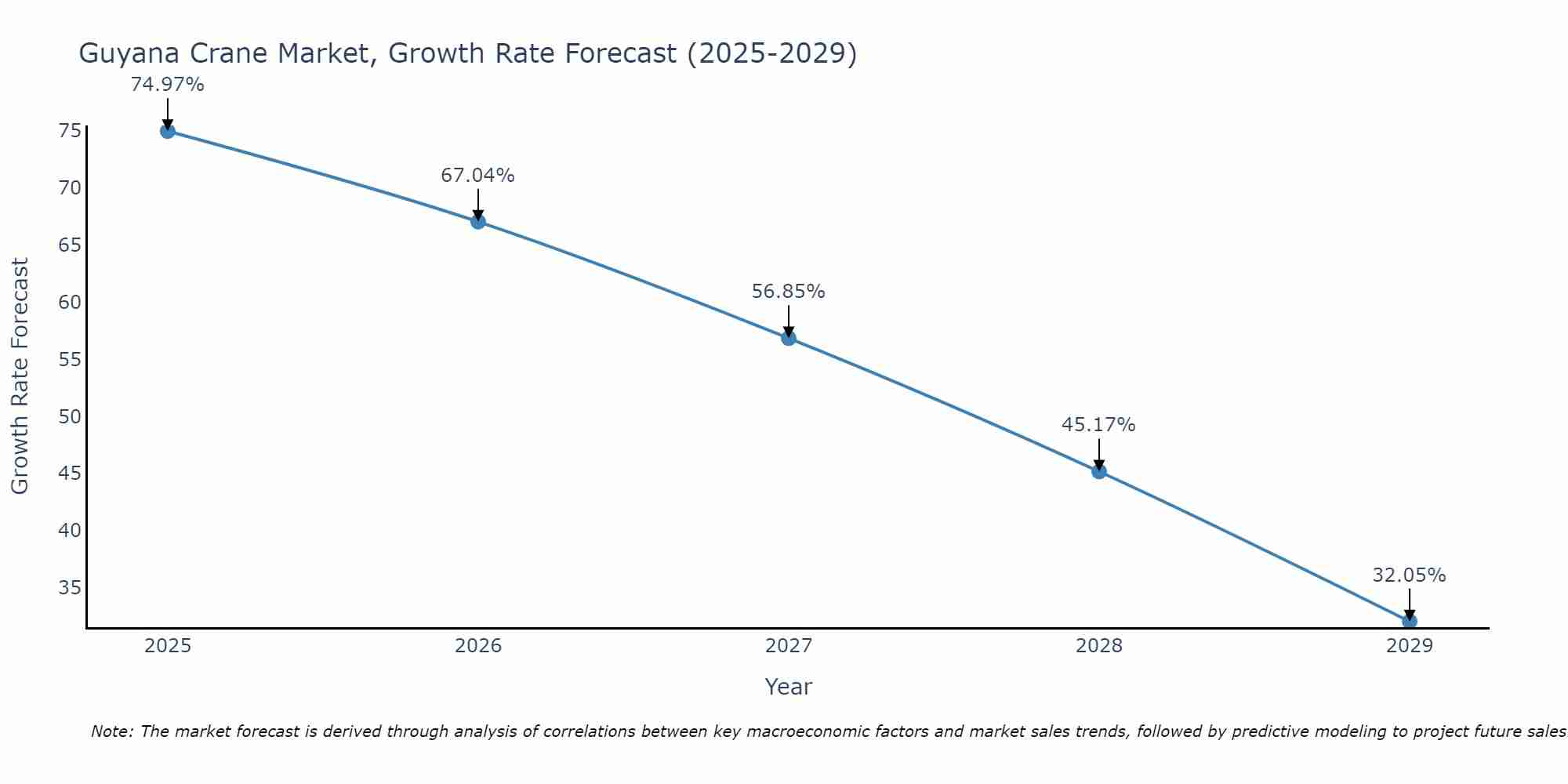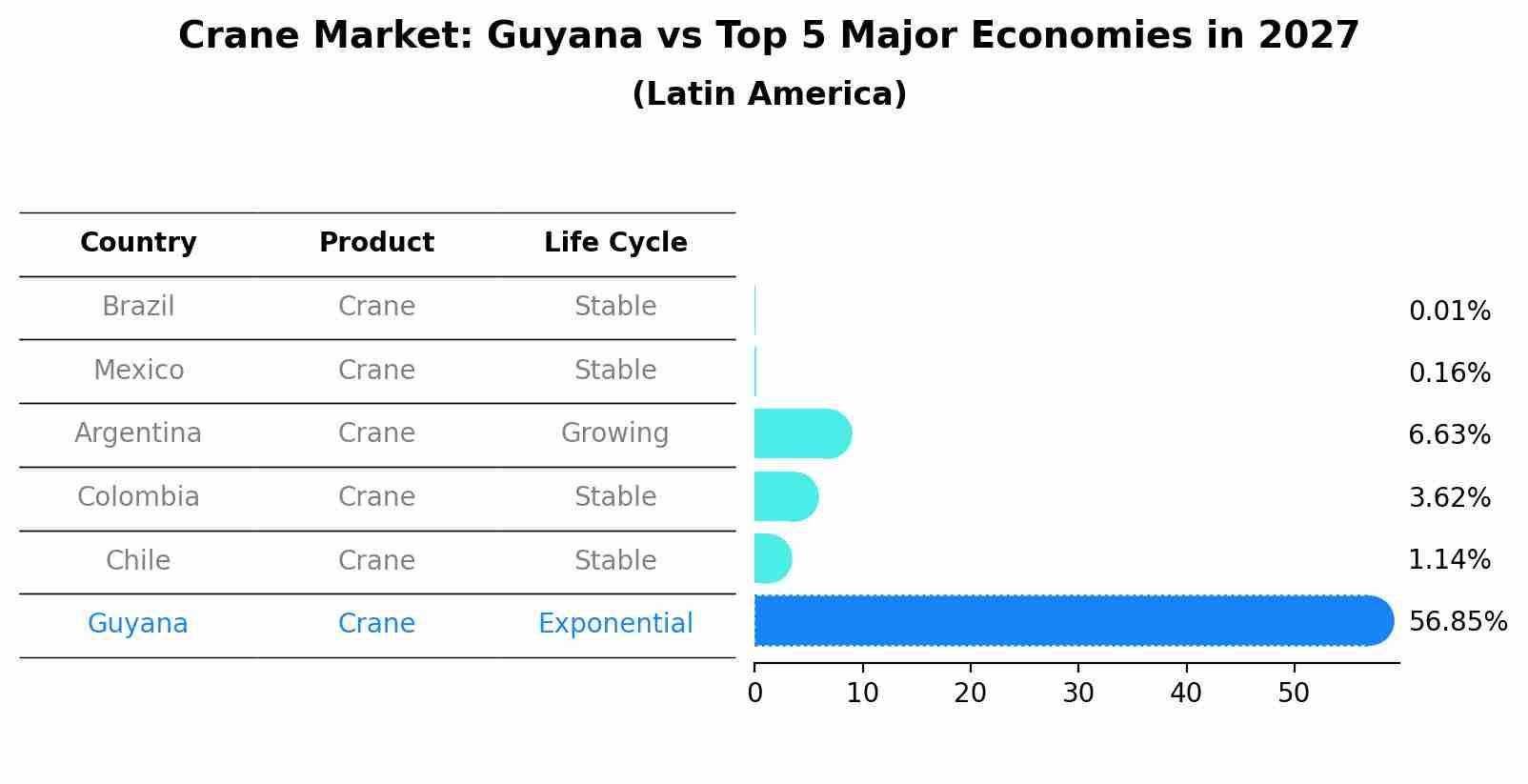Guyana Crane Market (2025-2031) | Share, Segmentation, Revenue, Trends, Growth, Size, Analysis, Outlook, Value, Industry, Companies & Forecast
| Product Code: ETC4782588 | Publication Date: Nov 2023 | Updated Date: Sep 2025 | Product Type: Market Research Report | |
| Publisher: 6Wresearch | Author: Sachin Kumar Rai | No. of Pages: 60 | No. of Figures: 30 | No. of Tables: 5 |
Guyana Crane Market Size Growth Rate
The Guyana Crane Market may undergo a gradual slowdown in growth rates between 2025 and 2029. Although the growth rate starts strong at 74.97% in 2025, it steadily loses momentum, ending at 32.05% by 2029.

Crane Market: Guyana vs Top 5 Major Economies in 2027 (Latin America)
Guyana's Crane market is anticipated to experience a exponential growth rate of 56.85% by 2027, reflecting trends observed in the largest economy Brazil, followed by Mexico, Argentina, Colombia and Chile.

Guyana Crane Market Overview
The crane market in Guyana is expanding, supported by the growth of the construction and infrastructure sectors. Increased investments in residential, commercial, and industrial projects have led to a higher demand for cranes. Manufacturers are focusing on offering versatile and energy-efficient models to cater to diverse project requirements. The market also benefits from advancements in crane technology, including remote monitoring and automation features.
Drivers of the market
The crane market in Guyana is expanding as the construction, mining, and oil and gas industries continue to grow. Cranes are essential for lifting heavy materials and equipment, and their demand is closely tied to the growth of infrastructure and industrial projects. As Guyanas economy diversifies, particularly in construction and energy sectors, there is an increasing need for cranes to support large-scale projects such as bridges, buildings, and oil rigs. Additionally, the rise in urbanization and the growth of commercial and residential real estate are driving the demand for cranes. The ongoing investments in infrastructure and heavy industries are expected to continue driving growth in the crane market.
Challenges of the market
The crane market in Guyana faces challenges primarily due to the limited demand for heavy machinery in the construction and industrial sectors. Although Guyana`s construction and oil and gas sectors are expanding, they remain smaller than those in other regions, limiting the need for cranes. Additionally, the high cost of acquiring and maintaining cranes, along with the need for specialized operators and maintenance personnel, makes them less accessible to small and medium-sized enterprises (SMEs). The market is also affected by the limited availability of financing options for companies looking to invest in cranes, as well as the reliance on imported equipment, which drives up costs.
Government Policy of the market
The crane market in Guyana, essential for construction, mining, and logistics, is growing due to ongoing infrastructure projects and industrial activities. With government-led initiatives to expand the transportation network and industrial base, there is an increasing demand for cranes to handle heavy lifting and construction tasks. Policies promoting infrastructure development and manufacturing are boosting this market.
Key Highlights of the Report:
- Guyana Crane Market Outlook
- Market Size of Guyana Crane Market, 2024
- Forecast of Guyana Crane Market, 2031
- Historical Data and Forecast of Guyana Crane Revenues & Volume for the Period 2021-2031
- Guyana Crane Market Trend Evolution
- Guyana Crane Market Drivers and Challenges
- Guyana Crane Price Trends
- Guyana Crane Porter`s Five Forces
- Guyana Crane Industry Life Cycle
- Historical Data and Forecast of Guyana Crane Market Revenues & Volume By Types for the Period 2021-2031
- Historical Data and Forecast of Guyana Crane Market Revenues & Volume By Mobile Crane for the Period 2021-2031
- Historical Data and Forecast of Guyana Crane Market Revenues & Volume By Fixed Crane for the Period 2021-2031
- Historical Data and Forecast of Guyana Crane Market Revenues & Volume By Marine and Offshore Crane for the Period 2021-2031
- Historical Data and Forecast of Guyana Crane Market Revenues & Volume By Applications for the Period 2021-2031
- Historical Data and Forecast of Guyana Crane Market Revenues & Volume By Industrial Applications for the Period 2021-2031
- Historical Data and Forecast of Guyana Crane Market Revenues & Volume By Marine and offshore for the Period 2021-2031
- Historical Data and Forecast of Guyana Crane Market Revenues & Volume By Mining and Excavation for the Period 2021-2031
- Historical Data and Forecast of Guyana Crane Market Revenues & Volume By Construction for the Period 2021-2031
- Historical Data and Forecast of Guyana Crane Market Revenues & Volume By Other Applicants for the Period 2021-2031
- Guyana Crane Import Export Trade Statistics
- Market Opportunity Assessment By Types
- Market Opportunity Assessment By Applications
- Guyana Crane Top Companies Market Share
- Guyana Crane Competitive Benchmarking By Technical and Operational Parameters
- Guyana Crane Company Profiles
- Guyana Crane Key Strategic Recommendations
Frequently Asked Questions About the Market Study (FAQs):
1 Executive Summary |
2 Introduction |
2.1 Key Highlights of the Report |
2.2 Report Description |
2.3 Market Scope & Segmentation |
2.4 Research Methodology |
2.5 Assumptions |
3 Guyana Crane Market Overview |
3.1 Guyana Country Macro Economic Indicators |
3.2 Guyana Crane Market Revenues & Volume, 2021 & 2031F |
3.3 Guyana Crane Market - Industry Life Cycle |
3.4 Guyana Crane Market - Porter's Five Forces |
3.5 Guyana Crane Market Revenues & Volume Share Segmentations, 2021 & 2031F |
3.6 Guyana Crane Market Revenues & Volume Share, By Applications, 2021 & 2031F |
4 Guyana Crane Market Dynamics |
4.1 Impact Analysis |
4.2 Market Drivers |
4.2.1 Increasing infrastructure development projects in Guyana |
4.2.2 Growing demand for construction and mining activities in the region |
4.2.3 Government initiatives to improve transportation and logistics sector in Guyana |
4.3 Market Restraints |
4.3.1 High initial investment cost for cranes |
4.3.2 Lack of skilled operators for operating advanced crane technologies in Guyana |
5 Guyana Crane Market Trends |
6 Guyana Crane Market Segmentations |
6.1 Guyana Crane Market Segmentations |
6.1.1 Overview and Analysis |
6.1.2 Guyana Crane Market Revenues & Volume, By Mobile Crane, 2021-2031F |
6.1.3 Guyana Crane Market Revenues & Volume, By Fixed Crane, 2021-2031F |
6.1.4 Guyana Crane Market Revenues & Volume, By Marine and Offshore Crane, 2021-2031F |
6.2 Guyana Crane Market, By Applications |
6.2.1 Overview and Analysis |
6.2.2 Guyana Crane Market Revenues & Volume, By Industrial Applications, 2021-2031F |
6.2.3 Guyana Crane Market Revenues & Volume, By Marine and offshore, 2021-2031F |
6.2.4 Guyana Crane Market Revenues & Volume, By Mining and Excavation, 2021-2031F |
6.2.5 Guyana Crane Market Revenues & Volume, By Construction, 2021-2031F |
6.2.6 Guyana Crane Market Revenues & Volume, By Other Applicants, 2021-2031F |
7 Guyana Crane Market Import-Export Trade Statistics |
7.1 Guyana Crane Market Export to Major Countries |
7.2 Guyana Crane Market Imports from Major Countries |
8 Guyana Crane Market Key Performance Indicators |
8.1 Average utilization rate of cranes in Guyana |
8.2 Number of new infrastructure projects in the pipeline |
8.3 Rate of adoption of advanced crane technologies in the market |
9 Guyana Crane Market - Opportunity Assessment |
9.1 Guyana Crane Market Opportunity Assessment Segmentations, 2021 & 2031F |
9.2 Guyana Crane Market Opportunity Assessment, By Applications, 2021 & 2031F |
10 Guyana Crane Market - Competitive Landscape |
10.1 Guyana Crane Market Revenue Share, By Companies, 2024 |
10.2 Guyana Crane Market Competitive Benchmarking, By Operating and Technical Parameters |
11 Company Profiles |
12 Recommendations | 13 Disclaimer |
- Single User License$ 1,995
- Department License$ 2,400
- Site License$ 3,120
- Global License$ 3,795
Search
Thought Leadership and Analyst Meet
Our Clients
Related Reports
- Vietnam System Integrator Market (2025-2031) | Size, Companies, Analysis, Industry, Value, Forecast, Growth, Trends, Revenue & Share
- ASEAN and Thailand Brain Health Supplements Market (2025-2031) | Strategy, Consumer Insights, Analysis, Investment Trends, Opportunities, Growth, Size, Share, Industry, Revenue, Segments, Value, Segmentation, Supply, Forecast, Restraints, Outlook, Competition, Drivers, Trends, Demand, Pricing Analysis, Competitive, Strategic Insights, Companies, Challenges
- ASEAN Bearings Market (2025-2031) | Strategy, Consumer Insights, Analysis, Investment Trends, Opportunities, Growth, Size, Share, Industry, Revenue, Segments, Value, Segmentation, Supply, Forecast, Restraints, Outlook, Competition, Drivers, Trends, Demand, Pricing Analysis, Competitive, Strategic Insights, Companies, Challenges
- Europe Flooring Market (2025-2031) | Outlook, Share, Industry, Trends, Forecast, Companies, Revenue, Size, Analysis, Growth & Value
- Saudi Arabia Manlift Market (2025-2031) | Outlook, Size, Growth, Trends, Companies, Industry, Revenue, Value, Share, Forecast & Analysis
- Uganda Excavator, Crane, and Wheel Loaders Market (2025-2031) | Strategy, Consumer Insights, Analysis, Investment Trends, Opportunities, Growth, Size, Share, Industry, Revenue, Segments, Value, Segmentation, Supply, Forecast, Restraints, Outlook, Competition, Drivers, Trends, Demand, Pricing Analysis, Competitive, Strategic Insights, Companies, Challenges
- Rwanda Excavator, Crane, and Wheel Loaders Market (2025-2031) | Strategy, Consumer Insights, Analysis, Investment Trends, Opportunities, Growth, Size, Share, Industry, Revenue, Segments, Value, Segmentation, Supply, Forecast, Restraints, Outlook, Competition, Drivers, Trends, Demand, Pricing Analysis, Competitive, Strategic Insights, Companies, Challenges
- Kenya Excavator, Crane, and Wheel Loaders Market (2025-2031) | Strategy, Consumer Insights, Analysis, Investment Trends, Opportunities, Growth, Size, Share, Industry, Revenue, Segments, Value, Segmentation, Supply, Forecast, Restraints, Outlook, Competition, Drivers, Trends, Demand, Pricing Analysis, Competitive, Strategic Insights, Companies, Challenges
- Angola Excavator, Crane, and Wheel Loaders Market (2025-2031) | Strategy, Consumer Insights, Analysis, Investment Trends, Opportunities, Growth, Size, Share, Industry, Revenue, Segments, Value, Segmentation, Supply, Forecast, Restraints, Outlook, Competition, Drivers, Trends, Demand, Pricing Analysis, Competitive, Strategic Insights, Companies, Challenges
- Israel Intelligent Transport System Market (2025-2031) | Strategy, Consumer Insights, Analysis, Investment Trends, Opportunities, Growth, Size, Share, Industry, Revenue, Segments, Value, Segmentation, Supply, Forecast, Restraints, Outlook, Competition, Drivers, Trends, Demand, Pricing Analysis, Competitive, Strategic Insights, Companies, Challenges
Industry Events and Analyst Meet
Whitepaper
- Middle East & Africa Commercial Security Market Click here to view more.
- Middle East & Africa Fire Safety Systems & Equipment Market Click here to view more.
- GCC Drone Market Click here to view more.
- Middle East Lighting Fixture Market Click here to view more.
- GCC Physical & Perimeter Security Market Click here to view more.
6WResearch In News
- Doha a strategic location for EV manufacturing hub: IPA Qatar
- Demand for luxury TVs surging in the GCC, says Samsung
- Empowering Growth: The Thriving Journey of Bangladesh’s Cable Industry
- Demand for luxury TVs surging in the GCC, says Samsung
- Video call with a traditional healer? Once unthinkable, it’s now common in South Africa
- Intelligent Buildings To Smooth GCC’s Path To Net Zero


















